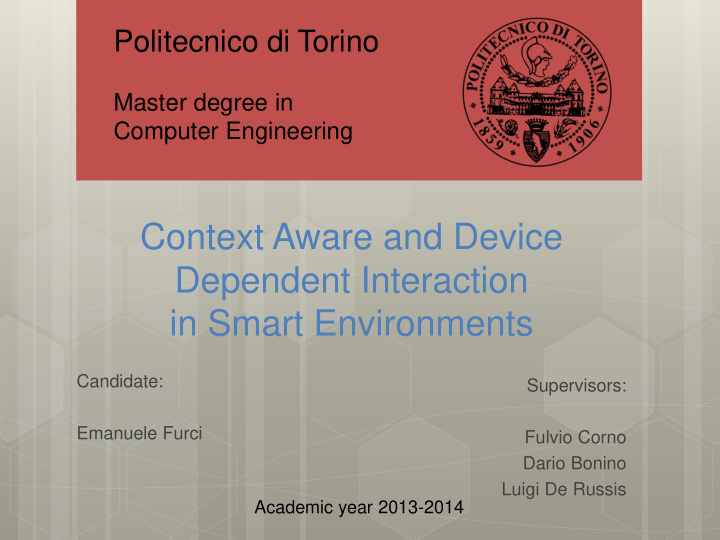



Politecnico di Torino Master degree in Computer Engineering Context Aware and Device Dependent Interaction in Smart Environments Candidate: Supervisors: Emanuele Furci Fulvio Corno Dario Bonino Luigi De Russis Academic year 2013-2014
Introduction – Data Modelling – Software Development – Scenario Test Case - Conclusions Outline Introduction Thesis work Data Modelling Software Development Scenario Test Case Conclusions 2
Introduction – Data Modelling – Software Development – Scenario Test Case - Conclusions Goal: An intelligent notification system for smart homes Take into account the surrounding context to select end user devices and send them generated messages 3
Introduction – Data Modelling – Software Development – Scenario Test Case - Conclusions 4
Introduction – Data Modelling – Software Development – Scenario Test Case - Conclusions Steps: create a data modelling infrastructure able to represent information about the context (domain of interest) develop a software to elaborate data model information and deliver house related messages to the appropriate end users device 5
Politecnico di Torino Master degree in Computer Engineering Data Modelling
Introduction – Data Modelling – Software Development – Scenario Test Case - Conclusions Data Modelling Definition of the Domain of Interest Users User Devices Smart Home Message Categories Ontology-Based Modelling Exploration of existing ontology for contex modelling 7
Introduction – Data Modelling – Software Development – Scenario Test Case - Conclusions Notont the Notification Ontology 4 directly imported ontologies Locont Device DogOnt Core 27 overall imported ontologies 1385 classes 8
Introduction – Data Modelling – Software Development – Scenario Test Case - Conclusions Notont – User Modelling Activity (e.g. eating, sleeping) Accessibility (e.g. freeable_hands) Location (e.g. livingroom, kitchen) Obtrusiveness (e.g. mobile_only, no_audio) End-User-Devices (e.g. smartphone, tablet) Message Categories (e.g. AppliancesAlert) 9
Introduction – Data Modelling – Software Development – Scenario Test Case - Conclusions Notont – Device Modelling Physical Features (e.g. screen size, camera) Capabilities (e.g. audio and video reproduction) 10
Introduction – Data Modelling – Software Development – Scenario Test Case - Conclusions Notont – House Modelling Architectural aspects (e.g. wall, window) Appliances (e.g. oven, HVAC system) Devices (e.g. smart tv, HiFi system) Furniture (e.g. couch, table) 11
Introduction – Data Modelling – Software Development – Scenario Test Case - Conclusions Notont – Message Category Modelling Priority (e.g. lower_level, highest_level) Attributes (e.g. min_temperature_value) 12
Introduction – Data Modelling – Software Development – Experimental Results - Conclusions Notont – Information modelling Information as Class instance Instance data properties Connections by means of object properties A single .owl file as data model 13
Introduction – Data Modelling – Software Development – Scenario Test Case - Conclusions Scenario Test Case 2 users (Luca, Giulia) 3 devices (LG Nexus 4, Samsung Galaxy Nexus, Samsung Galaxy Tab 10’’) 1 smart home (temperature and humidity sensors, smart plugs, door sensors,Hifi system) 6 message category (EnvironmentalComfort, PowerOverThreshold, EnergyManagement, AppliancesUsage, AppliancesAlert, SecurityAlert) 14
Politecnico di Torino Master degree in Computer Engineering Software Development
Introduction – Data Modelling – Software Development – Scenario Test Case - Conclusions Software Development Data Model Management Notont Manager User Interfacing UserManager House Interfacing and Message Generation House Message Manager Device Message Delivery Device Manager 16
Introduction – Data Modelling – Software Development – Scenario Test Case - Conclusions NINS: Notont-based Intelligent Notification System • Update User State (Obtrusiveness level, Location, etc) • Assumptions: • User Activity and Location • Data Model Management • • Receive Generated Receive Generated are known • Insert Messages Messages • Update • Delete • • Get end user Devices from Get end user Devices from • Query Notont Manager Notont Manager • Implements the device inferring process • • Send Messages to Devices Send Messages to Devices 17
Introduction – Data Modelling – Software Development – Scenario Test Case - Conclusions NINS – Device Manager Android – Based Devices Gcm Service Mobile application on Devices 22
Politecnico di Torino Master degree in Computer Engineering Scenario Test Case
Introduction – Data Modelling – Software Development – Scenario Test Case - Conclusions Scenario Test Case 2 users (Luca, Giulia) 3 devices (LG Nexus 4, Samsung Galaxy Nexus, Samsung Galaxy Tab 10’’) 1 smart home (temperature and humidity sensors, smart plugs, door sensors,Hifi system) 6 message category (EnvironmentalComfort, PowerOverThreshold, EnergyManagement, AppliancesUsage, AppliancesAlert, SecurityAlert) 24
Introduction – Data Modelling – Software Development – Scenario Test Case - Conclusions Video 25
Politecnico di Torino Master degree in Computer Engineering Conclusions
Introduction – Data Modelling – Software Development – Scenario Test Case - Conclusions Conclusions Notont – Notification Ontology Formal representation of context information in Smart Environments Inferring of the most suitable end user device NINS – Notont-based Intelligent Notification System Data model Management House and User interfecing Sending messages to devices 27
Introduction – Data Modelling – Software Development – Scenario Test Case - Conclusions Future Works Test in a real home setting Usage of the context to infer “ how ” send a message to end users devices Increase supported devices 28
Politecnico di Torino Master degree in Computer Engineering Thank You!
Extra Slides Notont the Notification Ontology 30
Extra Slides Notont & scenario modelling 31
Extra Slides Scenario: Giulia modelling 32
Extra Slides Query the model – Giulia’s activity 33
Extra Slides Android user application 34
Recommend
More recommend